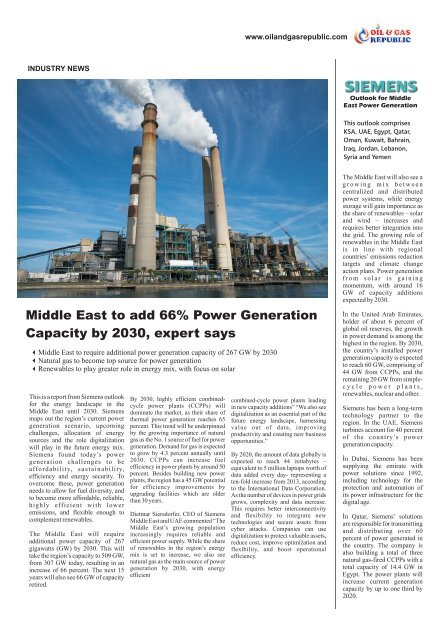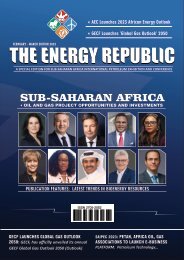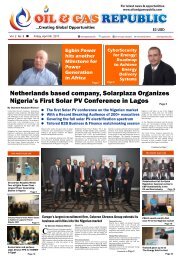Middle East Electricity & Solar 2017
Oil & Gas Republic is an exhibitor & media partner at Middle East Electricity & Solar 2017. This Newspaper publication is a spotlight on the Middle East Electricity & Power Sector. Middle East Electricity is an essential event in the MEA power community’s calendar, and the 2017 edition will be an unmissable opportunity for anyone with a professional interest to learn about the future of energy in cities. Informa Exhibitions is the organizer of Middle East Electricity & Solar 2017, one of the world’s leading power exhibitions. For more information, visit http://oilandgasrepublic.com
Oil & Gas Republic is an exhibitor & media partner at Middle East Electricity & Solar 2017. This Newspaper publication is a spotlight on the Middle East Electricity & Power Sector. Middle East Electricity is an essential event in the MEA power community’s calendar, and the 2017 edition will be an unmissable opportunity for anyone with a professional interest to learn about the
future of energy in cities. Informa Exhibitions is the organizer of Middle East Electricity & Solar 2017, one of the world’s leading power exhibitions. For more information, visit http://oilandgasrepublic.com
Create successful ePaper yourself
Turn your PDF publications into a flip-book with our unique Google optimized e-Paper software.
www.oilandgasrepublic.com<br />
INDUSTRY NEWS<br />
Outlook for <strong>Middle</strong><br />
<strong>East</strong> Power Generation<br />
This outlook comprises<br />
KSA, UAE, Egypt, Qatar,<br />
Oman, Kuwait, Bahrain,<br />
Iraq, Jordan, Lebanon,<br />
Syria and Yemen<br />
<strong>Middle</strong> <strong>East</strong> to add 66% Power Generation<br />
Capacity by 2030, expert says<br />
<strong>Middle</strong> <strong>East</strong> to require additional power generation capacity of 267 GW by 2030<br />
Natural gas to become top source for power generation<br />
Renewables to play greater role in energy mix, with focus on solar<br />
This is a report from Siemens outlook<br />
for the energy landscape in the<br />
<strong>Middle</strong> <strong>East</strong> until 2030. Siemens<br />
maps out the region’s current power<br />
generation scenario, upcoming<br />
challenges, allocation of energy<br />
sources and the role digitalization<br />
will play in the future energy mix.<br />
Siemens found today’s power<br />
generation challenges to be<br />
affordability, sustainability,<br />
efficiency and energy security. To<br />
overcome these, power generation<br />
needs to allow for fuel diversity, and<br />
to become more affordable, reliable,<br />
highly efficient with lower<br />
emissions, and flexible enough to<br />
complement renewables.<br />
The <strong>Middle</strong> <strong>East</strong> will require<br />
additional power capacity of 267<br />
gigawatts (GW) by 2030. This will<br />
take the region’s capacity to 509 GW,<br />
from 307 GW today, resulting in an<br />
increase of 66 percent. The next 15<br />
years will also see 66 GW of capacity<br />
retired.<br />
By 2030, highly efficient combinedcycle<br />
power plants (CCPPs) will<br />
dominate the market, as their share of<br />
thermal power generation reaches 65<br />
percent. This trend will be underpinned<br />
by the growing importance of natural<br />
gas as the No. 1 source of fuel for power<br />
generation. Demand for gas is expected<br />
to grow by 4.3 percent annually until<br />
2030. CCPPs can increase fuel<br />
efficiency in power plants by around 50<br />
percent. Besides building new power<br />
plants, the region has a 45 GW potential<br />
for efficiency improvements by<br />
upgrading facilities which are older<br />
than 30 years.<br />
Dietmar Siersdorfer, CEO of Siemens<br />
<strong>Middle</strong> <strong>East</strong> and UAE commented “The<br />
<strong>Middle</strong> <strong>East</strong>’s growing population<br />
increasingly requires reliable and<br />
efficient power supply. While the share<br />
of renewables in the region’s energy<br />
mix is set to increase, we also see<br />
natural gas as the main source of power<br />
generation by 2030, with energy<br />
efficient<br />
United Arab Emirates<br />
Nuclear Power Plant<br />
Photo: venturesonsite<br />
combined-cycle power plants leading<br />
in new capacity additions” “We also see<br />
digitalization as an essential part of the<br />
future energy landscape, harnessing<br />
value out of data, improving<br />
productivity and creating new business<br />
opportunities.”<br />
By 2020, the amount of data globally is<br />
expected to reach 44 zettabytes –<br />
equivalent to 5 million laptops worth of<br />
data added every day- representing a<br />
ten-fold increase from 2013, according<br />
to the International Data Corporation.<br />
As the number of devices in power grids<br />
grows, complexity and data increase.<br />
This requires better interconnectivity<br />
and flexibility to integrate new<br />
technologies and secure assets from<br />
cyber attacks. Companies can use<br />
digitalization to protect valuable assets,<br />
reduce cost, improve optimization and<br />
flexibility, and boost operational<br />
efficiency.<br />
The <strong>Middle</strong> <strong>East</strong> will also see a<br />
g r o w i n g m i x b e t w e e n<br />
centralized and distributed<br />
power systems, while energy<br />
storage will gain importance as<br />
the share of renewables – solar<br />
and wind – increases and<br />
requires better integration into<br />
the grid. The growing role of<br />
renewables in the <strong>Middle</strong> <strong>East</strong><br />
is in line with regional<br />
countries’ emissions reduction<br />
targets and climate change<br />
action plans. Power generation<br />
f r o m s o l a r i s g a i n i n g<br />
momentum, with around 16<br />
GW of capacity additions<br />
expected by 2030.<br />
In the United Arab Emirates,<br />
holder of about 6 percent of<br />
global oil reserves, the growth<br />
in power demand is among the<br />
highest in the region. By 2030,<br />
the country’s installed power<br />
generation capacity is expected<br />
to reach 60 GW, comprising of<br />
44 GW from CCPPs, and the<br />
remaining 20 GW from simplec<br />
y c l e p o w e r p l a n t s ,<br />
renewables, nuclear and other.<br />
Siemens has been a long-term<br />
technology partner to the<br />
region. In the UAE, Siemens<br />
turbines account for 40 percent<br />
of the country’s power<br />
generation capacity.<br />
In Dubai, Siemens has been<br />
supplying the emirate with<br />
power solutions since 1992,<br />
including technology for the<br />
protection and automation of<br />
its power infrastructure for the<br />
digital age.<br />
In Qatar, Siemens’ solutions<br />
are responsible for transmitting<br />
and distributing over 60<br />
percent of power generated in<br />
the country. The company is<br />
also building a total of three<br />
natural gas-fired CCPPs with a<br />
total capacity of 14.4 GW in<br />
Egypt. The power plants will<br />
increase current generation<br />
capacity by up to one third by<br />
2020.















